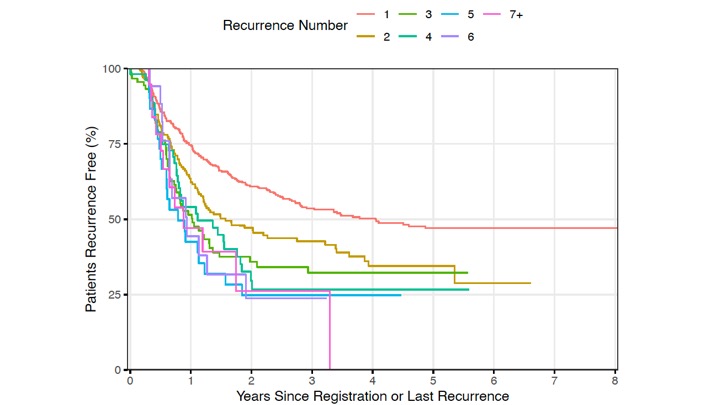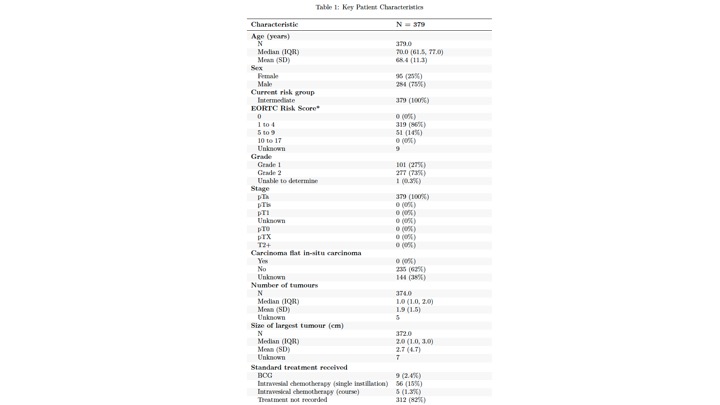Back
Poster, Podium & Video Sessions
Podium
PD26: Bladder Cancer: Non-invasive I
PD26-08: Low-grade urothelial carcinoma recurs at a tempo that naturally accelerates from Adagio to Allegro
Saturday, May 14, 2022
2:10 PM – 2:20 PM
Location: Room 252
Alex Sankin*, Bronx, NY, Louise-Rae Cherrill, Rebecca H. Boucher, Birmingham, United Kingdom, Maurice P. Zeegers, Maastricht, Netherlands, K. K. Cheng, Birmingham, United Kingdom, Nicholas D. James, London, United Kingdom, Mark Schoenberg, Ilir Agalliu, Bronx, NY, Richard T. Bryan, Birmingham, United Kingdom
- AS
Podium Presenter(s)
Introduction: Patients with low grade urothelial carcinoma are at a lifetime risk of recurrence and often require multiple interventions including repeat transurethral resections and intravesical therapy. We present an exploratory analysis of the frequency of recurrence in patients with low grade intermediate-risk non-muscle invasive bladder cancer (NMIBC) from a comprehensive large-scale prospective cohort in the UK.
Methods: The Bladder Cancer Prognosis Programme (BCPP) is a prospective cohort of 1191 patients with newly-diagnosed bladder cancer who were recruited from 2005-2011 at 10 urological centers within the West Midlands, UK, and who remain under follow-up. Risk group was assigned according to European Association of Urology criteria. Time to first recurrence is defined as the time from registration to detection of first recurrence of bladder cancer; time between first recurrence and second recurrence is defined as the time from the detection of the first recurrence to the detection of the second recurrence, and so on for time between subsequent recurrences. All recurrence-free intervals are calculated using the Kaplan-Meier method.
Results: We identified 379 patients with G1/G2 pTa tumors classified as intermediate risk (Table 1). Median age was 70 and 284/379 (75%) were male. 53% of patients had at least one recurrence after 5 years of follow-up. 1-year recurrence-free survival (RFS) was 75%, 2-year RFS was 61%, 3-year RFS was 54%, and 4-year RFS was 50%. The median time to 1st, 2nd, 3rd, 4th, and 5th sequential recurrence was 49, 19, 12, 14, and 10 months, respectively (Figure 1).
Conclusions: Over half of patients with low grade urothelial tumors are destined to recur. As tumors recur sequentially over time, the rate of recurrence appears to accelerate. The natural cadence of tumor recurrence may represent a kinetic biomarker that could inform both surveillance and intervention protocols.
Source of Funding: Urogen Pharma


Methods: The Bladder Cancer Prognosis Programme (BCPP) is a prospective cohort of 1191 patients with newly-diagnosed bladder cancer who were recruited from 2005-2011 at 10 urological centers within the West Midlands, UK, and who remain under follow-up. Risk group was assigned according to European Association of Urology criteria. Time to first recurrence is defined as the time from registration to detection of first recurrence of bladder cancer; time between first recurrence and second recurrence is defined as the time from the detection of the first recurrence to the detection of the second recurrence, and so on for time between subsequent recurrences. All recurrence-free intervals are calculated using the Kaplan-Meier method.
Results: We identified 379 patients with G1/G2 pTa tumors classified as intermediate risk (Table 1). Median age was 70 and 284/379 (75%) were male. 53% of patients had at least one recurrence after 5 years of follow-up. 1-year recurrence-free survival (RFS) was 75%, 2-year RFS was 61%, 3-year RFS was 54%, and 4-year RFS was 50%. The median time to 1st, 2nd, 3rd, 4th, and 5th sequential recurrence was 49, 19, 12, 14, and 10 months, respectively (Figure 1).
Conclusions: Over half of patients with low grade urothelial tumors are destined to recur. As tumors recur sequentially over time, the rate of recurrence appears to accelerate. The natural cadence of tumor recurrence may represent a kinetic biomarker that could inform both surveillance and intervention protocols.
Source of Funding: Urogen Pharma



.jpg)
.jpg)